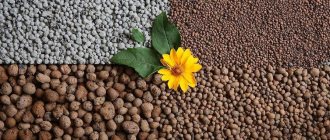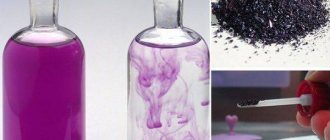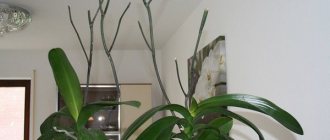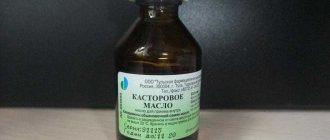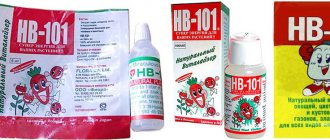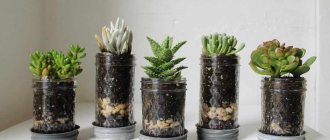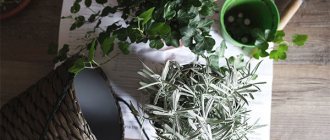If you are planning to green your home, you will probably install pots with various plants. This adds a feeling of coziness and comfort, and also makes the house more conducive to living. A newbie in this business asks many questions, such as what kind of pebbles are used in office pots and some houses. You can even buy ready-made soil with stones at the garden center, but not everyone understands what it is. In fact, pebbles in pots serve not only a decorative purpose, although it looks really beautiful. Having understood the usefulness of such an element in the composition of the soil, you probably also want to add pebbles to the soil of your pots.
Drainage for indoor plants according to the rules
If there is no “stone” drainage, it is replaced with polystyrene foam and its analogues.
When growing hydroponically, drainage completely replaces the growing substrate; in fact, the entire technology is drainage. In plastic or polymer pots it is easy to make holes yourself, but when purchasing ceramic and terracotta pots you need to evaluate the drainage capabilities of the pots more carefully. 4. Before you start replanting the plant and laying the drainage, make sure that the tools and materials themselves are clean. Check the instructions for the purchased drainage: some types of special expanded clay, vermiculite and perlite need to be saturated with moisture before laying. Agroperlite is not drainage, but one of the best mineral additives for soil. For each planned transplant, create a new drainage layer. It is advisable to use fresh drainage material. The thickness of the drainage is usually divided (conventionally) into low, medium and high. I can only say that high drainage is about a quarter of the height of the pot, medium drainage is up to 1/5, and low drainage is up to 1/6 of the height.
But it should be noted that it does not last forever: after 5 years, expanded clay will turn into something similar to soil, so sometimes it needs to be replaced. You won't be able to use a large pot for it because there is too much risk of flooding, and a small one will be unstable. It is in this situation that it is worth remembering such drainage material as crushed stone. The only downside may be that moss is not always available; you can collect it yourself, or you can buy it.
How to properly arrange drainage
In order to avoid clogging of the holes, an impeccable layer of stones should be laid on the bottom of the tank, thanks to which the liquid will flow out through the holes. A thick layer of soil and roots can also clog drainage holes.
If this happens the next time it is moistened, then you need to start transplanting the flowers into another container with fresh soil mixture.
Material selection
As for what material is best to use for drainage, in this case it all depends on your imagination. In most cases, plant growers prefer expanded clay, crushed stone, polystyrene foam, pebbles, small bricks, gravel, and others. Basically, drainage is laid at a height of 3 centimeters from the bottom of the flowerpot. For individual flowers, fill the pot by a third. Others belong to such plants.
When choosing a material for drainage, flower growers most prefer expanded clay. It is sold in every flower shop. Expanded clay quite easily absorbs moisture, and releases it after the soil dries. The remaining excess water leaves the pot without much difficulty, flowing down the spherical stones.
Expanded clay is a very lightweight material that does not burden the tank with the flower and can serve as drainage for approximately 4 years. When a transplant is performed, it is changed. Expanded clay pebbles can also be used to mulch the top layer of soil. It prevents the formation of a crust and the drying out of the soil. Expanded clay allows water to pass to the roots and prevents the formation of moss and mold.
You can do the draining yourself. Ceramic dishes or bricks are very similar in their qualities to expanded clay. They are all made from baked clay. Expanded clay is a good material for drainage, which is crushed into small pieces before use.
Gravel and crushed stone have good strength. Water flows through them perfectly, and there is no destruction. The only disadvantage of such materials is that they are heavy and the earth is supercooled. Stones do not retain heat, so flowers with similar drainage are best placed on south-facing windows.
Foam is also used for drainage. There is no mold on it and no rotting. Crushed foam does not absorb liquid, allowing it to easily pass to the drainage holes. In addition, polystyrene foam protects indoor flowers from hypothermia. It is quite soft, therefore, young roots often go deeper into it. At the next transplant they are simply eliminated. A layer of polystyrene foam measuring 3 cm is placed on the bottom of the flowerpot, then a small layer of sand and soil. After which you can plant indoor plants.
When transplanting and planting, it is imperative to use drainage for indoor flowers. This will protect the flowers from excess moisture and supply the root system with oxygen.
Under no circumstances should you use eggshells or nutshells for drainage. When moisture affects these materials, they can rot, mold, and affect the acidity of the soil, which ultimately leads to various diseases in indoor plants. If you do not react immediately, the flower may die.
Sand is not yet allowed. When watering, it becomes filled with soil particles and simply clogs the drain holes, which leads to stagnation of moisture at the roots and their rotting. It is permissible to use river pebbles, as long as you need to get rid of the sand.
Professionals do not recommend using granite and marble chips for drainage. This can be explained by the fact that the salts that are present in granite and marble act with water and very strongly acidify the soil.
Drainage includes not only excellent liquid permeability material, but also the ability to reduce flowing liquid. If water regularly stagnates in the stand, then drainage is simply not needed here. This is why it is necessary to drain the excess liquid after the next moistening. If this possibility is excluded, then the tank on the pallet must be placed on an elevation so that the lower part of the tank is in the air and not in the water.
How to make and decorate pots for indoor flowers with your own hands? Possible materials for manufacturing
How to properly use aqua soil for flowers
Stones in landscape design: a selection of interesting solutions
Paths
Paving with stones will become not only a stylish element, but also a practical solution. In modern landscape design, both step-by-step and main paths are made of stone. For paving the main paths, wild flat stone is often used, and for step-by-step paths, special slabs of granite or sandstone are used. The modern assortment of stones offers a large selection of such slabs: you can find large-sized, aged, and various shapes. When paving the main path, do not use fill, chips or small pebbles. These stones will get stuck in the soles of shoes and spread throughout the area, creating an unkempt appearance for the garden.
Retaining walls
Retaining walls are a necessary element in areas where there is a slope. On the one hand, they strengthen the soil, and on the other hand, they become a decorative design element, allowing you to create multi-level gardens. If the height difference in the area is large, then you need to build a retaining wall that will protect against landslides. Cover its foundation with thin slabs of natural stone to make this complex engineering structure a stunning decorative element. An excellent design solution would be to clad the foundation of the house and the retaining wall with the same stone. This way the landscape will be harmonious. If the difference is small, then you can immediately use a stone. Choose suitable wild stones in the store, stack them on top of each other, creating a unique landscape on your site. Such walls can also be erected for decorative purposes: to construct a fence, create a multi-level garden, or decorate a slope. Please note the height restrictions for retaining walls without a foundation. Such walls cannot be designed too high.
Rockery
A rockery is a composition of stones and plants on a plane. From the outside it seems as if you are deceiving nature - plants grow directly from stones. But in reality, all it takes is a little smart planning. Any coniferous or flowering plants are suitable for rockeries, and choose stones so that they are combined with other stone elements on the site: cladding of buildings or paths.
Rock garden (alpine slide)
A rock garden is a composition of stones and plants that imitates natural alpine landscapes: slopes and gorges decorated with vegetation are reminiscent of trips to the mountains. A proper rock garden, as a rule, requires a large area and plants from the alpine region, which in the middle zone must be carefully looked after, and some even need to be covered for the winter.
Dry bodies of water
A dry body of water - a dry pond or a dry stream - is a stylish and unusual element of the landscape. Artificial depressions in the ground are filled with stones of bluish, grayish and white shades, imitating a river or pond. Plants are planted along the banks. You can install a decorative bridge or organize a “green” island with conifers and flowering plants, adding believability to the landscape. Such a pond looks amazing, especially with thoughtful lighting.
Czech rolling pin
The Czech rolling pin is an imitation of real rocks using flat stones laid at an angle to the ground. Plants are planted between groups of such stones, creating amazing compositions that are so pleasant to admire. To make the Czech rolling pin especially decorative, try playing with plant shades that will highlight the relief of the composition.
Rock garden
The rock garden is a gift from Japanese culture: a composition of rough stones placed on gravel in a specific order. Sometimes coniferous or deciduous plants are added to emphasize the severity of the stone. As a rule, the background for such a composition is a backfill of gravel, which is arranged according to color, imitating waves. This garden is ideal for those who enjoy peace and privacy or appreciate Japanese heritage. In order to create such a garden, you need to delve into its philosophy and understand all the subtleties.
Gabions
Gabions are the most flexible stone structure and can be used in many different ways, from fences and woodsheds to small figurines. It is a frame made of metal mesh, the base of which is filled with stones.
Relaxation area and fire pit
Not a single garden plot is complete without a recreation area. Decorating it with stone is a great move. Firstly, this is a stylish solution, and secondly, the stone will preserve the neat appearance of the area for a long time, preventing the growth of weeds. Lay out a stone platform, install several benches or armchairs, and place an interestingly shaped fire bowl in the center, and a cozy corner for relaxing with family and friends is ready.
What can drainage be made from?
Different types of plants require different drainage patterns and sizes. The drainage component can be small, medium or large, but each of them must equally have the following properties:
- not to mold;
- do not rot;
- let water through;
- do not give any chemical reactions;
- do not damage the root of the plant.
Drainage is used not only for house plants, but also for garden ones.
The most popular type of drainage for indoor flowers is baked clay, medium/fine fraction, called expanded clay. Expanded clay has a porous structure and performs its function perfectly. It retains excess moisture, and as the soil and roots dry out, it returns it to them.
In addition to expanded clay for drainage, the following materials are used:
- crushed stone;
- ceramic shards;
- gravel;
- polystyrene foam (or similar synthetic material);
- vermiculite;
- perlite;
- peat;
- sphagnum moss;
- charcoal;
- broken brick.
To make the right choice of drainage material, you need to have information about them:
Polystyrene foam is a good material for drainage, but the flower root gradually grows into it. It is necessary to replant such plants carefully so as not to damage the root system. Ceramic shards are laid out with the convex side facing up, but it is worth remembering that the root can be injured by sharp edges. When using broken shards, they are sprinkled with sand on top
It is very important that the shards are not large in size, otherwise sand will seep through and clog the free space through which excess moisture escapes. Broken brick can damage the root with its sharp edges, so it is used quite carefully in rare cases. White sand-lime brick has an advantage over red clay brick because it is able to absorb moisture and at the same time retain it, and then release it back as the soil dries. Crushed stone and gravel are more often used in garden plots; they have a long service life.
Sphagnum moss has disinfectant healing properties and also retains moisture well. Before using this natural material, fill it with warm water for about half an hour. This procedure will saturate the moss with moisture and get rid of insects.
The only problem is that such moss is not easy to buy; it is often not available for sale. You can collect moss yourself in the fall in wet/wet forest areas. Moss is often used to grow orchids. Charcoal is used not only as drainage, but also as fertilizer. It has an antiseptic effect, adsorbs salts, and regulates moisture saturation. Coal is laid on the bottom of the pot in a 2-centimeter layer, choosing large fractions that will not leak through the holes. He also works according to the system - absorb, then give.
Vermiculite perfectly absorbs all available moisture, as well as fertilizers. After a while, he continues to feed the plant, giving it everything that he initially saved. This lightweight material is prepared by heating clay, which causes the minerals to compress like scales; it is absolutely harmless to the plant. Externally, vermiculite is similar to cork or wood shavings. Perlite has one drawback - its high cost, but otherwise it is an excellent drainage material that absorbs, retains and releases moisture as needed. Outwardly, it resembles white/gray granules and is of volcanic origin.
It is worth considering that drainage also has its own shelf life, for example, expanded clay needs to be changed every 5-8 years, otherwise it decomposes, becoming part of the soil.
Reproduction
Lithops are propagated by lateral shoots and seeds. Seeds remain viable for 10 years, but those that have been stored for 3 years germinate best.
The first method is easier. It is enough to separate the shoot from the mother plant and plant it in permanent soil.
The seed method will require significantly more time and labor. To obtain seeds, flowers are pollinated by hand. The resulting seeds (they look like fruits) should be thoroughly dried. To do this, they are placed in a warm (22–25⁰С), dry and dark place for 4–6 months. Then they are filled with water for 3–6 hours and sown. The container is covered with glass or film. Water with a spray bottle. After the sprouts appear (after 7–10 days), the container is opened. The seedlings must be kept at a temperature of 25–28 degrees, regularly sprayed and ventilated. Picking is done every other year, in the spring.
It is enough to pay a minimum of attention to the “living stones” so that they constantly delight you with their exotic beauty.
Proper drainage of house plants
The health and even life of the green pet ultimately depends on how correctly the gardener organizes the drainage system.
With all the abundance of flower pots, one cannot help but notice that the vast majority of them are plastic pots. Experienced gardeners even make additional drainage cuts in the side of the pot when replanting this orchid. The ability of such plants to grow in swamps in their natural habitat does not mean that they can exist in the waterlogged soil of a flower pot. Consequently, fewer holes are made in the pot. But first of all, you must become familiar with the peculiarities of growing each specific type of indoor flower.
This is the cheapest and most readily available drainage material. Moreover, unlike bricks, pebbles and shards, polystyrene foam is much lighter, which means it does not weigh down the pot.
Both the upper foliage part of the plants and the root system must be able to breathe.
This procedure is not limited only to the presence of holes; it is also necessary to use special drainage material.
You need to put the pot on its side and clean them with a stick. Some types of plants have such a developed root system that it fills the entire space of the pot. Through the drainage holes, the roots will be clearly visible and you can easily monitor their condition.
Only materials of inorganic origin are suitable for creating a drainage layer. For example, marble chips are absolutely not suitable for drainage, since with prolonged interaction with water, they significantly reduce the acidity of the soil, making it excessively alkaline.
However, not everyone knows that installing a drainage layer in a bowl is not as simple as it seems at first glance. The drainage system also includes soil that has water- and breathable properties. That is why proper drainage is one of the most important steps when planting indoor flowers. It's safe to say that all indoor plants need drainage, but the drainage system may vary.
You can purchase drainage mixture at a flower shop or at a construction site if, for example, you decide to buy crushed stone. After planting flowers, it is worth checking whether the drainage system works well.
Almost all beginning flower growers believe that drainage is the same expanded clay that is sold in stores. The main one is increasing the acidity of the nutrient solution that the roots consume. You can agree with this statement, or you can argue. In any case, your humble servant has been using expanded clay as a drainage material for many years, and has not noticed any negative effect on plants. Therefore, their calibration and cleaning falls on the shoulders of the grower. At its core, this is also a pretty good drainage material. Before creating a drainage layer from broken bricks, it also needs to be prepared.
The largest shard is placed at the bottom of the pot, in the center of which a hole is made. Then the main substrate is added and the plant is planted. Foam plastic is excellent as drainage for flowers. Poinsettia from the Euphorbia family is an amazingly beautiful plant.
Can such pain be tolerated? How much money have you already wasted on ineffective treatment?
The use of organic materials for drainage - nut or eggshells, tree bark - is strictly prohibited. For more information, you can watch a video on how to make your own indoor plant drainage. It is prohibited to use materials such as marble and granite chips, especially the first one, as drainage.
Materials
The main materials used to construct the drainage layer are:
- expanded clay,
- broken brick,
- clay shards, fragments of pottery,
- Styrofoam,
- pebbles, small crushed stone, gravel,
- charcoal,
- perlite, vermiculite
The use of each of them has both its pros and cons, which are sometimes overlooked.
Expanded clay
Perhaps the most popular material for drainage, sold in all supermarkets and specialized flower shops. The direct purpose of expanded clay is construction insulation, but the material is so well suited for creating a drainage layer that it has become widely used in floriculture.
Expanded clay or expanded clay gravel are particles of foamed and baked clay. The size of expanded clay fractions can be different - from coarse to small, almost sandy. In floriculture, as a rule, medium-fraction expanded clay (from 5 to 20 mm) is used.
One of the valuable properties of expanded clay, like other clay materials, is the ability to accumulate moisture and release it when necessary. Thus, an optimal water balance is maintained in the substrate.
Advantages of expanded clay used as a drainage material:
- availability and low price,
- light weight,
- ability to absorb water,
- durability (service life is at least 4-5 years).
However, using expanded clay also has its disadvantages. For example, according to some gardeners, it is capable of changing the acid-base balance of the soil, which negatively affects the health of the green pet.
[!] Sometimes it is useful to sprinkle expanded clay onto the surface of the substrate, eliminating overheating of the soil and excessive evaporation from its surface. However, in some cases this can lead to disruption of air exchange and the appearance of mold.
Recently, expanded clay enriched with microelements has appeared on the counter of flower shops. It’s hard to say whether it’s a miracle product or an advertising ploy to increase sales. You can only try it in practice and share your findings.
Broken brick
Red brick is a building material made from clay, so the properties of red brick chips are very similar to expanded clay. If, for some reason, it is not possible to buy expanded clay, you can completely get by with broken bricks, arranging a drainage layer from this material.
Clay shards, fragments of pottery
Another readily available material for drainage is shards and broken pottery. Some gardeners collect broken cups and plates, using them later to create a drainage layer.
And this is quite justified: they are light in weight, do not absorb or retain moisture. The only disadvantage of the fragments is the sharp corners, which can easily injure you, so it is better to work with such drainage material while wearing thick gloves.
Styrofoam
Recently, a new trend has emerged among flower growers - using pieces of polystyrene foam as drainage. And while some people are distrustful of this synthetic material, others, without hesitation, fill the bottom of a flower pot with it.
Polystyrene foam is, in fact, foamed, cellular plastic, and it is used everywhere, from construction to packaging of various goods. Foam plastic, as a drainage material, has many advantages:
- availability,
- sterility (does not create a favorable environment for the development of fungi),
- lack of absorption.
Polystyrene foam does not absorb or release moisture at all, which, in some cases, is its undeniable advantage. If the grower needs a drainage layer that retains water, a little hydrogel can be mixed into the pieces of polystyrene foam.
However, this material also has some disadvantages, for example:
- the ability of roots to grow through the foam (which makes it difficult to remove during transplantation),
- too light weight.
The last property of the material creates some inconvenience when using it in light plastic pots: unstable dishes with a weak base can tip over under the weight of the plant. On the other hand, the lightness of polystyrene foam is an undoubted advantage when filling bulky ceramic dishes. This material will not add weight to an already heavy flower pot.
Pebbles, crushed stone, gravel
Another free drainage material used by many indoor plant lovers is small pebbles: pebbles, crushed stone or gravel. The use of small fragments of stones is quite justified - they allow water to pass through perfectly without retaining or absorbing it.
However, there are also significant disadvantages. Pebbles, crushed stone, and gravel are heavy, and a container partially filled with these materials can simply become too heavy to lift. However, in the case of using a drainage layer of stones in a lightweight plastic pot, the disadvantage turns into an advantage - the plastic container will be stable and will not tip over.
Another disadvantage of stones, noted by many experienced gardeners, is their high thermal conductivity. Therefore, a plant overwintering on a windowsill may become hypothermic and, accordingly, get sick.
Coal
An excellent natural material for drainage is charcoal. His positive qualities:
- porosity,
- sterility,
- neutrality.
Pathogenic fungi that cause mold do not develop in coal, and therefore the roots of a plant in a substrate with coal will be much less susceptible to rotting. Coal does not change the acid-base balance of the soil and has disinfecting properties. And you can not only buy coal, but also collect it completely free of charge, which is important in the case of an extensive flower collection.
However, in every barrel of honey there is a fly in the ointment. If we talk about coal as a component of the drainage layer, it is:
- moisture absorption is too high,
- excessive lightness,
- packiness.
Vermiculite and perlite
Despite their different origins, vermiculite and perlite have common properties: resistance to infection, sterility, low thermal conductivity, and therefore can be used as a drainage layer. The soil, which contains these two components, is much less acidic, and fungi and mold practically do not multiply in it. As a rule, the above materials are used as additives to the substrate, but their use in pure form as drainage is also quite justified.
The only drawback of these materials is their high price and inaccessibility: they can only be bought in specialized flower shops.
What are drainage holes and why are they needed?
The pot must have a way
to drain excess water. To do this, holes are made at the bottom of the pot, which are called drainage holes.
Their number can vary from one to one and a half dozen depending on the characteristics and needs of the flower.
If there are no holes in the pot, then you can make them yourself without any problems. And humidity control
soil begins already at this stage: the thicker the holes are, the faster the water will leave the pot, and the more oxygen the root system will receive.
The number of holes has a similar effect on the removal of moisture and enrichment of soil with oxygen.
Drain hole
Over time, it can become clogged with soil mixture, drainage or roots. Therefore, it needs to be checked periodically, especially when there is only one. If you notice that the hole is clogged, it should be cleaned. A wooden or other stick will do for this.
What kind of florariums are there?
Florariums can be closed or open, tabletop, floor or wall. But the main thing is wet tropical or dry succulent.
Closed florariums
a complex version of florariums, since an ecosystem with its own microclimate is created inside the container. Once the plants are planted, the container closes tightly and no further maintenance is required. Such mini-ecosystems are difficult to calculate correctly, and, as a rule, they are short-lived.
Closed florarium
Open florariums
A simpler version of florariums, this is what we will consider in more detail.
Separately, you can also distinguish orchidariums (compositions with orchids) and florariums with bonsai .
Open florarium with echveria
Other elements and basic requirements
What material is used if the necessary elements are not at hand? If you cannot find any of the above materials, do not worry, there is always a way out. Use what you have on hand. So, what can replace drainage?
- Crushed stone and gravel. Drainage made from these stones perfectly replaces the traditional one. The only drawback is that these elements significantly make the pot heavier. So if you take a small pot or one that you won’t often move from place to place, this material will work best.
- Aquarium stone. Such stones are a good alternative, but the price is quite high. But if you have this material, why not use it?
- Styrofoam. Foam plastic perfectly replaces the usual elements. It meets the necessary requirements, and besides, it can be found almost everywhere. People tend to store boxes of appliances or household appliances, so there is no better budget option for drainage. True, they don’t crumble it into a pot, but cut it into cubes and lay it in a layer of several centimeters. Of course, a significant disadvantage can be damage to the root system if the roots of the plant entwine the foam.
- Brick. You can also replace traditional materials with broken bricks. This is a natural material with the necessary properties. However, before placing it on the bottom of the pot, sharpen the edges, otherwise the roots of the plant may be damaged. White brick is better suited for use rather than red.
We also mentioned the basic requirements earlier. It is necessary to ensure that the drainage has the necessary properties and does not harm the plant. This will be enough to achieve the desired result.
Answers from experts
Leka+:
In addition to expanded clay and brick chips, you can use small pebbles (aquarium grade), shells (if you suddenly have a bunch of unnecessary ones from the holidays), you can simply break old clay pots or unnecessary cups and plates. For very small plants and small pots, you can use coconut fiber or pieces of natural loofah or sisal sponges and pieces of natural sponge. And as a temporary measure (while the cuttings are rooting, while the seedlings are growing) - even pieces of polystyrene foam
A.T.:
Broken brick!
In large pots, when the root of the plants is small, then half of it, sometimes even more, is filled with cones
Galina Zelinskaya:
Crushed RED brick, expanded clay
Irina:
If the pot is large, but expanded clay or bricks are not at hand, then you can use used tea bags. which should be placed on the bottom of the pot in one layer.
Marina Chepurnaya:
expanded clay, foam plastic
Nina Tuzova (Kvashnina):
pistachio shells. advised. but I haven't tried to do that myself
Elena Protopopova:
Bricks, pebbles, old shards, etc. WASH ONLY!!!
Anna Glivatskaya:
You can use walnut shells, just pre-treat them in a manganese solution
Ms. Flora:
And also pine bark, it is useful not only for orchids, as an antiseptic, but it is good to put it on the bottom or in the soil. It both disinfects and drains.
Maximka:
Why shells? Not all plants need this lime. Shards, expanded clay and even pieces of foam.
avmir:
Broken brick, crushed stone, expanded clay, but not shells. And generally avoid limestone, chalk, and gypsum.
Tane4ka:
I don't think shells are a good idea. Sea salted ones need to be washed, washed, washed. Again, the edges are sharp and the roots may get cut. And they will alkalize. Expanded clay or small stones are better.
Clementine Lady:
I like expanded clay as drainage. Lightweight, washes well when replanting, does not injure the roots, there are large ones and small ones, for any holes in the pot. I didn’t notice any disadvantages when using it.
Irina K:
You can use coals from a fire
Irina Smirnova:
I like to use pebbles and gravel. Easily found on the street, in any size. Then just wash it thoroughly and put it in the bottom of the pot. Excellent drainage is obtained. Sometimes I use expanded clay, but not all plants like it. For example, I have adeniums. They do not tolerate expanded clay. As soon as the roots in the pot grow to the expanded clay drainage layer, the leaves immediately begin to turn yellow and drop. For a long time I struggled with the problem of yellowing leaves, until someone here on “ANSWERS” told me that I need to give up expanded clay for adeniums. I replaced the expanded clay drainage with fine crushed stone - everything was fine. Well, Adena doesn’t like expanded clay...
Photo Lady:
I always place one large flap of flat shell in the center of the drain hole. So that the roots don't get out there. In general, all my pots have many holes, so the bottom layer is pebbles, very large bark (I have mostly orchids, but there are others), large pieces of charcoal, and then the necessary soil or substrate. Pebbles are also needed to weigh down small pots. In large plants I put a pebble in each hole. at the bottom of a huge pot. The water drains, but the earth does not wake up.
tsuatsua tsautsautsa:
It is better to do drainage s polyfacture /catalog/livnevaya-kanalizatsiya/ correctly and efficiently, so that the flowers are watered constantly, then there will be no problems, this is called storm drainage.
What is drainage and what is it for?
Most houseplants require a soil composition that provides approximately 15% air, 50% solids and 35% water. Only a properly constructed drainage layer can create such optimal conditions.
This is explained by the fact that with excessive watering, the same percentages of air content that are vital for flowers are displaced. When there is no oxygen in the soil, pathogenic bacteria begin to develop, the root system rots, and the flower begins to wither.
Drainage for flowers, photos of various types of which are presented in the article, precisely ensures the removal of excess moisture and ventilation of the roots.
To lay the drainage layer, you can use various materials, such as gravel, foam plastic or any synthetics, expanded clay, moss, crushed stone, charcoal, broken brick, river sand, peat and others. Next, the most commonly used materials will be discussed in more detail.
An important quality of drainage is good water throughput, chemical inertness, resistance to rotting and mold.
Drainage for flowers has different fractions, which are selected depending on the plants.
How to properly lay a drainage layer
It is important not only to choose the right materials, but also to properly lay the drainage layer
What rules exist that you absolutely need to pay attention to? Let's consider the main postulates:
- The main issue is the thickness of the drainage layer. The average height is about 2-3 centimeters. However, the specific height of the interlayer is determined by 3 factors: The shape of the container. If the pot is narrow and high, then the layer should be approximately 1/4 of the height (after all, the soil in them takes longer to dry out), if it is wide and low, then 1/8 (the soil dries out faster), if the vessel is standard and has a proportional width and height , then the layer size is 1/6 of the height.
- The material from which the vessel is made. If the plant is planted in a container that has a porous structure (for example, clay), then the drainage may be less; if the container is airtight (for example, glass, plastic, glazed ceramic), then the layer should be larger.
- Dimensions and number of drainage holes. The number of holes affects the thickness of the layer: the more there are, the smaller the layer can be, and vice versa, the fewer holes, the thicker the layer should be. However, the diameter of the holes also plays an important role: if the holes are small, then the layer should be larger and vice versa.
Materials for the drainage layer can be reused (with the exception of perlite or small stones, small expanded clay, crushed brick; it is quite difficult to separate them from the soil). After removing them from the bottom of the container, they must be washed, disinfected (for example, in a dark solution of potassium permanganate or chlorhexidine) and dried.
- When planting or replanting any plants, you must use new, clean and dry materials! Do not place dirty or undisinfected materials. If you bought drainage in a store, read the instructions.
- If you buy a houseplant and it comes with instructions, be sure to read them carefully. Drainage requirements may be specified there.
- It is optimal to make drainage in 2 layers: on the bottom there is material of large fractions (expanded clay, crushed stone, gravel, ceramic chips), and on top put smaller elements (perlite, broken brick or at least coarse sand).
- If you use only fine-grained materials, then sprinkle a small layer of soil on them before planting.
- The drainage layer must be even. After planting the plant, you need to carefully walk along the walls of the container and shake it slightly so that the material is evenly distributed.
What plants can be planted in a florarium?
When selecting compositions, they carefully study not only the decorative characteristics, but also the plant preferences for soil, requirements for lighting, humidity and care: the “neighbors” in the florarium must have all the same parameters.
The main rule when choosing a plant is that it should be dwarf and have a very slow growth rate.
Florarium with open succulents
Plants for a tropical florarium
- Ferns: maidenhair, or lady's hair; asplenium; multi-row; pteris;
- trees: ficus microcarpa, myrsina, Japanese maple, pomegranate, etc.;
- tillandsias, now very popular tillandsias from the atmospheric group are used for planting together with succulents, while the remaining species are more suitable for tropical florariums;
- orchids: miniature phalaenopsis, hybrids of phalaenopsis and Kinga dendrobiums, ludisia, paphiopedilum;
- ivy, varieties with small leaves and low growth rate);
- hypocyrta;
- hypoesthes;
- fittonia;
- cryptanthus , or earth star;
- Pilea;
- selaginella;
- soleirolia (for ground cover in large florariums).
Plants for succulent florarium
There will be enough space in the florarium for succulents for about 1.5–2 years. If one of the succulents grows too much, it can be transplanted into a separate pot and a smaller succulent can be planted in the florarium instead.
Suitable for planting:
- adenium;
- echeveria (echeveria) and its relatives;
- slipway;
- aloe: miniature species, like a. aristata or a. brindle;
- gasteria;
- haworthia;
- living stones , or lithops;
- small cacti: astrophytums, gymnocalyciums, mammillaria, etc.);
- aichrizon (can be formed in the form of a tree);
- Crassula;
- aeonium (small specimens).
Brief description and necessity
It is quite simple to explain why and why this component is so important in the field of growing flowers. The thing is that without drainage, the soil gradually becomes compacted and dries out unevenly from moisture. In addition, areas with excess moisture appear, which can turn sour and cause rotting of the root system. Experts say that the spread of dangerous diseases and pests, lack of air permeability and rotting of the soil, disruption of the normal outflow of excess moisture, as well as an anaerobic environment are not all the factors that a small layer of drainage at the bottom of the container can successfully cope with.
Experts note that such material is a universal soil drainage system that helps maintain the most favorable substrate moisture for each type of indoor plant. Simply put, this is a specific layer of coarse or coarse-grained materials at the bottom of a flower pot, which guarantees good air permeability to the soil, as well as optimal drainage of excess moisture.
Novice florists often forget that good air permeability plays an important role in the process of growing a healthy plant. After all, only in this case will the root system of the flower be able to breathe and develop normally.
https://youtube.com/watch?v=DQghHByiU1w
The most common mistakes when creating a florarium
1. Planting plants too densely leads to the fact that the florarium quickly loses its decorativeness and structure.
2. Mixing in one florarium crops that require different growing conditions.
3. Too little drainage layer leads to the root system of plants getting wet.
4. Excessive number of decorative elements.
5. Use of large and fast-growing crops, such as anthuriums or philodendrons, in a small florarium.
6. The use of vessels is too complicated in shape. Thus, a highly curved surface reflects light well and makes it more difficult to remove dust and dirt from the inner walls.
7. Use of glass or colored glass, as well as containers made of matte-colored plastics. They distort the light spectrum and disrupt plant physiology.
Best answers
avmir:
When I was a snotty kid, there were only ceramic pots with one hole in the bottom. This hole was covered with a shard from broken dishes, and as soil they took soil from a garden or forest belt and mixed it with coarse river sand (cherozem from molehills was especially valued). That's all the drainage, and also a good nutritional substance.
Alisa Doronina:
Crushed polystyrene foam.
Academician:
Broken brick, if there is no expanded clay, although it costs a penny.
Lirriella:
Why replace it? Useful thing. Expanded clay works well. Or, if you grow it on a wick, you don’t need it.
riba xitraya:
sphagnum, but expanded clay is best
Polystyrene foam is essentially not drainage, but... fill in the excess volume so that there is less soil, less risk of flooding. It does not come into contact with water, and the essence of drainage is to absorb excess water and release it at the right time
SPINY LIKE A HEDGEHOG...:
Throw any stones...
Clementine Lady:
Expanded clay, ceramic fragments, polystyrene foam. You can add agroperlite to the soil, it will prevent overflow.
Irina K:
Pieces of charcoal are very good for use as drainage.
I:
crushed stone or fine gravel ideal for drainage
Elena Rudenko:
That's what drainage is for, to absorb excess moisture (if the plant is flooded). It’s better not to stuff nonsense into the pot, like polystyrene foam, which doesn’t perform its intended function. It is better to purchase high-quality drainage. I buy Flower drainage large and small from Fusco. It completely and completely fulfills its function.
Ruslan Ladushkin:
You can, in principle, use a drainage system quite cost-effectively now) acoline ordered excellent prices here. and the guys there are great. In general, it’s up to you to decide, but I really advise you won’t regret it)
Evgeniy Volkov:
acoline/
Additional tips, recommendations
House flowers, like the gardener himself, do not always care what kind of drainage you use. Therefore, when choosing it, you need to be guided by both your preferences and the needs of the plants. In this regard, you should heed the following recommendations:
- If accessibility is the main thing for you, then give preference to foam, cork, ceramic shards or brick (whatever comes to hand). You can even use old aquarium rocks or walnut shells.
- If drainage qualities, safety and accessibility are equally important, then it is better to choose expanded clay, crushed stone or gravel.
- If the flower is prone to root rot (or you often overwater the soil), then choose charcoal or sphagnum.
- If you don’t like unnecessary steps (crushing material, disinfecting), buy perlite or vermiculite.
- If the above-ground part of the plant is very massive and the root system is shallow, then heavy drainage will help give stability to the pot. In this case, crushed stone or gravel will do.
Whatever material you choose to construct the drainage layer, it should be quite large. The diameter of individual pebbles should be about 2 cm. Larger sizes are acceptable if for some reason you planted the flower in a pot without drainage holes. In any case, you must make sure that all stones are free of sharp corners and edges. Otherwise, they need to be sharpened to prevent damage to the roots.
